
Guilford County is a county located in the U.S. state of North Carolina. As of the 2020 census, the population is 541,299, making it the third-most populous county in North Carolina. The county seat, and largest community, is Greensboro. Since 1938, an additional county court has been located in High Point. The county was formed in 1771. Guilford County is included in the Greensboro-High Point, NC Metropolitan Statistical Area, which is also included in the Greensboro–Winston-Salem–High Point, NC Combined Statistical Area.
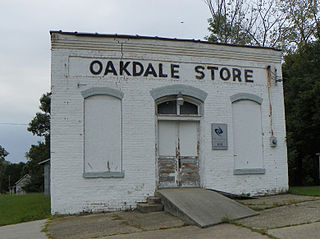
Jamestown is a town in Guilford County, North Carolina, United States. It is a suburb of the nearby cities of Greensboro and High Point. The population was 3,382 at the 2010 census.

Gibsonville is a town in both Alamance and Guilford counties in the U.S. state of North Carolina. Most of Gibsonville is situated in the Greensboro-Winston-Salem-High Point Combined Statistical Area and the eastern portion is in the Burlington, North Carolina Metropolitan Statistical Area, encompassing all of Alamance County. According to the 2020 census, the population of Gibsonville was 8,971.

Somerset Place is a former plantation near Creswell in Washington County, North Carolina, along the northern shore of Lake Phelps, and now a State Historic Site that belongs to the North Carolina Department of Natural and Cultural Resources. Somerset Place operated as a plantation from 1785 until 1865. Before the end of the American Civil War, Somerset Place had become one of the Upper South's largest plantations.
The Colonsay Plantation was one of the very earliest tracts of land to be granted in the Ceded Lands, while the Province of Georgia still belonged to the British Crown. It was named after the Scottish island Colonsay.

The Palmer-Marsh House is a historic house museum and National Historic Landmark on Main Street south of Carteret Street in Bath, North Carolina. Built in 1744, it is one of the oldest residences in North Carolina, and is a well-preserved example of a large colonial town house with a commercial space built in. It was declared a National Historic Landmark in 1970. It is now a North Carolina state historic site, and is open for tours.

The Chowan County Courthouse is a historic courthouse in Edenton, the county seat of Chowan County, North Carolina. Built in 1767, it is one of the finest examples of public Georgian architecture in the American South. It was declared a National Historic Landmark in 1970.
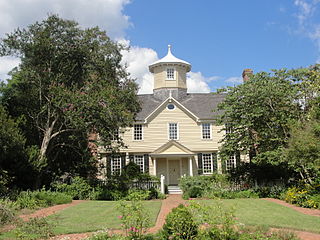
The Cupola House is a historic house museum in Edenton, North Carolina. Built in 1756–1758, it is the second oldest building in Edenton, and the only known surviving example in the American South of a "jutt," or overhanging second floor. It was declared a National Historic Landmark in 1970.
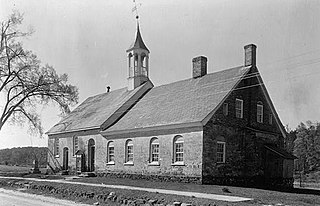
Bethabara Historic District encompasses the surviving buildings and archaeological remains of a small Moravian community, that was first settled in 1753. Located in present-day Forsyth County, North Carolina, it is now a public park of the city of Winston-Salem. It was designated National Historic Landmark in 1999.

The Nash-Hooper House, also known as the William Hooper House, is a historic house at 118 West Tryon Street in Hillsborough, North Carolina. Built in 1772 by American Revolutionary War general Francis Nash, it was home from 1782–1790 to Founding Father William Hooper, a signer of the United States Declaration of Independence. It is the only known home of Hooper's to survive, and was declared a National Historic Landmark in 1971. It is located in the Hillsborough Historic District; it is a private residence, and is not normally open to the public.
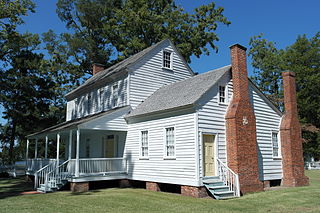
Bonner House is a historic home located at Bath, Beaufort County, North Carolina. It was built about 1835, and is a two-story frame dwelling with a one-story wing and rear shed addition. It sits on a brick pier foundation and has a side-hall plan. It is on land once owned by John Lawson, explorer and founder of Bath.

Hillsborough Historic District is a national historic district located at Hillsborough, Orange County, North Carolina. The district encompasses 529 contributing buildings, 9 contributing sites, 13 contributing structures, and 2 contributing objects in the central business district and surrounding residential sections of Hillsborough. The district includes buildings dating to the late-18th and early-20th century and includes notable examples of Federal, Greek Revival, and Italianate style architecture. Located in the district are the separately listed Burwell School, Eagle Lodge, Hazel-Nash House, Heartsease, Montrose, Nash Law Office, Nash-Hooper House, Old Orange County Courthouse, Poplar Hill, Ruffin-Roulhac House, Sans Souci, and St. Matthew's Episcopal Church and Churchyard. Other notable buildings include Seven Hearths, the Presbyterian Church (1815-1816), Methodist Church (1859-1860), First Baptist Church (1862-1870), Twin Chimneys, and the Berry Brick House.

Wessington House is a historic home located at Edenton, Chowan County, North Carolina. It was built about 1851, and is a 3-story house with a full English basement, brick dwelling with a center hall plan. The front facade features a two-tiered full-length porch with elaborate iron railings and balustrade.

Isaac Taylor House, also known as the Taylor-Ward House, is a historic home located at New Bern, Craven County, North Carolina. It was built about 1796, and is a three-story, three bay, side hall plan Federal style brick dwelling.
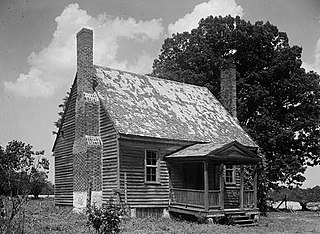
Cascine is a historic plantation complex and national historic district located near Louisburg, Franklin County, North Carolina. The district encompasses 12 contributing buildings, 4 contributing sites, and 3 contributing structures. The main house was built about 1850, and is a large two-story, Greek Revival style frame dwelling, in the manner of Jacob W. Holt, with Gothic Revival style influences. Also on the property is a small, one-story frame dwelling dated to about 1752. It was repaired and refurbished in the mid-20th century. Also on the property are the contributing brick kitchen, frame stable, granary, carriage house, family cemetery, slave cemetery, remains of slave quarters, tenant house, six log and frame tobacco barns, grist mill complex, and archaeological sites.
Jamestown Historic District is a national historic district located at Jamestown, Guilford County, North Carolina. The district encompasses nine contributing buildings in the Quaker community of Jamestown dated to the early-19th century. Located in the district is the separately listed Richard Mendenhall Plantation Buildings. Other notable buildings include the Richard Mendenhall Store, Jamestown Friends' Meeting House, Dr Shubal Coffin's House and Medical School, Dr. Coffin's second house, Harper-Johnson House, Mcinnis House, Joyner House, and Potter Log House.
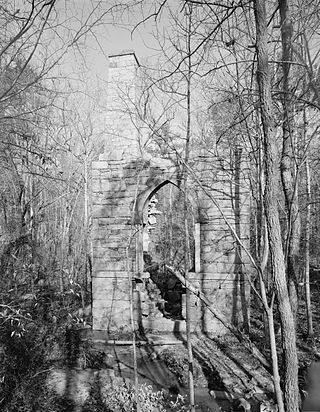
McCulloch's Gold Mill, also known as Rock Engine House, North State Mine, is a historic gold mill located near Jamestown, Guilford County, North Carolina. It consists of the ruins of the McCulloch Gold Mill, built of dry laid random ashlar granite construction in 1832. The ruins consist of two walls: one 29 feet, 6 inches long; and the second 24 feet, 8 inches wide. The second wall incorporates a chimney and Gothic arched opening.
Gardner House is a historic home located near Jamestown, Guilford County, North Carolina. It was built in 1827, and is a two-story, four bay by two bay, brick dwelling. It has a one-story, four bay rear wing and features an unusual arch-linked double chimney. The interior has a modified Quaker plan. Also on the property is the site of the Gardner gold mine.
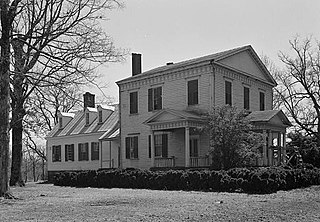
Elgin is a historic plantation house located near Warrenton, Warren County, North Carolina. It was built about 1835, and is a two-story, three bay, Federal style temple-form frame dwelling. It has a gable roof, pedimented front porch, and flanking porches. At the rear is an earlier 1+1⁄2-story frame dwelling with a gable roof. The front facade features a Palladian entrance with sidelights and Tuscan colonnettes. The house is similar in style to Dalkeith.
Buck Spring Plantation, also known as the Nathaniel Macon House, is a historic plantation house site located near Vaughan, Warren County, North Carolina. The property includes the graves of politician Nathaniel Macon (1757–1837) and his wife Hannah Plummer Mason, log corn crib, smokehouse, caretaker's house, and reconstructed dwelling house dated to the 1930s.




















